Sometimes problems do occur so please get in contact by adding a comment at the bottom of this page and I’ll do my best to try and help. Please remember to use a real email address when you post a comment so that I can get in contact if necessary (your email address will not be visible publicly).
Contents
- Latest support news
- 11 Feb 2024 – Google Drive folder restrictions
- 29 Jul 2022 – Uploading to Amazon Drive ending on 31 Jan 2023
- 6 Feb 2022 – Publishing and exporting hangs after one photo
- 18 Oct 2020 – Pinterest no longer authenticates
- 6 Sep 2018 – Picasa Web retires on 15 Mar 2019
- 20 Jul 2018 – Facebook prevents plug-in from being authorised
- 15 Jun 2018 – 500px no longer supports plug-ins
- 24 Apr 2018 – Facebook prevents plug-in from creating posts on user timelines
- 23 Jan 2018 – Picasa Web uploads fail (“500” error)
- 27 Feb 2017 – SmugMug no longer allows photos to be uploaded to “Private” galleries
- 7 Feb 2017 – Picasa Web changes (e.g. albums cannot be created)
- 7 Feb 2017 – Picasa Web uploads fail (“501” error)
- 27 Jan 2017 – Picasa Web uploads fail (“400” error)
- 19 Apr 2016 – Facebook authentication fails
- 16 Feb 2016 – Google announce changes to Picasa Web
- 13 Nov 2015 – Lightroom hangs/freezes when closing
- 7 Oct 2015 – Zenfolio communication fails
- 31 Jul 2014 Old “Picasa Web Upload” plug-in replaced by “Photo Upload”
- 27 Jun 2014 – Flickr authentication fails
- FAQ
- Updating the plug-in – always check you have the latest
- Downloaded plug-in from Adobe’s website and I have a ZXP file…
- Lightroom reports “An error occurred while attempting to load this plug-in.“
- Missing plug-in – The “nil” plug-in is not installed
- Authentication problem – Error authenticating with [service]
- What is the Export Location used for?
- Lightroom says my computer is out of disk space
- Location information not being uploading
- Old versions of Photo Upload for OneDrive (and the previous SkyDrive Upload) cannot be authenticated
- WordPress self-hosted sites
- WordPress blog site selection
- WordPress authentication does not return an authentication code
- Plug-in not compatible with your version of Lightroom
- Lightroom’s Plug-in Manager’s “Remove” button is disabled
- Unreceived license key
- Lost my license key
- Plug-in says the license key is invalid
- Can I rename the plug-in folder?
- Google’s Picasa Web photo size constraints
- Create multiple publish services
- Checking the version of your plug-in
- Removing a plug-in
- Saving your log file
Latest support news
11 Feb 2024 – Google Drive folder restrictions
Starting with version 5.9.6, the Photo Upload plug-in no longer lists Google Drive folders that it has not created itself, including shared folders and shared drives. All the upload capabilities still exist, but any folder that has not been created by the plug-in is not visible and cannot be uploaded to.
Google have announced that the Photo Upload plug-in can no longer access any folder or file that the plug-in has not created itself, including shared folders and shared drives. I’ve done my best to try and persuade the Google app verification team that accessing these folders is very useful to people uploading their photos to Google Drive, but Google have not been flexible on enforcing the new restrictions.
29 Jul 2022 – Uploading to Amazon Drive ending on 31 Jan 2023
Amazon have announced that they have deprecated Amazon Drive and are ending it on 31 Dec 2023 and preventing new files being uploading to it on 31 Jan 2023. This plug-in uses Amazon Drive to upload photos such that they can be viewed in Amazon Photos. On the date that Amazon prevents the plug-in uploading files to Amazon Drive this plug-in will no longer support uploading photos to Amazon. Unfortunately Amazon have not provided an alternative approach for apps such as this plug-in. The future approach for uploading photos to Amazon Photos after Jan 2023 is therefore going to be via the Amazon website or Amazon’s own apps.
6 Feb 2022 – Publishing and exporting hangs after one photo
With Lightroom 11.2, Adobe introduced a bug that causes publishing and exporting to hang after one upload. This has been reported here: https://community.adobe.com/t5/lightroom-classic-bugs/p-update-publish-collection-stalls/idi-p/12749232.
There seems to be one solution which involves clicking on a different collection when the publish/export first appears to hang. The second solution is simply to re-install Lightroom Classic 11.1 instead of 11.2.
Hopefully Adobe will fix this in the next update for Lightroom.
Update 12 Apr 2022 – Adobe report they have fixed (in Lightroom Classic 11.3) the hanging when publishing a collection.
18 Oct 2020 – Pinterest no longer authenticates
Photo Upload no longer authenticates with Pinterest and cannot currently be used to upload photos to Pinterest. It seems that Pinterest have disabled the API that the plug-in uses to communicate with Pinterest.
Photo Upload uses v1 of the API from Pinterest and has been an approved app by Pinterest since 2015 (it went through their approval process). Pinterest announced on their developer website sometime in early 2020 that there was a new v2 API available.
On 17 Apr 2020 the Photo Upload plug-in applied to use the v2 API.
On 5 Aug 2020 Pinterest sent me a notification that “the current version of the Pinterest Developer API will be deprecated in three months, on October 31, 2020.“
Note: Deprecation does not mean “removed”, but I think in this instance Pinterest actually meant to use the word “disabled”. The word “deprecation” is used to announce that something will be removed in the future.
Pinterest asked that apps apply for the v2 API. I contacted Pinterest saying that the app had applied for the v2 API back in Apr.
On 31 Aug 2020 Pinterest sent me this reply: “Unfortunately, this is no ETA when the new apps will be approved as I have mentioned we are a very small team and currently experiencing a large backlog of applications. We’re working as fast as we can to review and get back to everyone and also we do not prioritize requests for any users as of now. I hope this clarifies.“
On 18 Oct (or perhaps a few days earlier) Pinterest disabled the v1 API and the Photo Upload plug-in stopped working. Clearly this was before the 31 Oct date that they previously announced the API would be “deprecated” on.
I’ve emailed the developer support at Pinterest again and again over the past 6 months.
On 26 Oct I received the latest reply from them: “I can totally sense the trouble you’re experiencing on your end and I apologize for that. However, we’re bounded with limitations on our end. As I mentioned earlier, the requests for the app are getting reviewed by our internal team. I too agree that it has taken a longer time than expected. But please be assured as I’ve forwarded your feedback to our team. And, I’m sure they will look into your concern and get back to you at the earliest.“
Unfortunately there is nothing more I can do to encourage Pinterest to grant Photo Upload access to the v2 API. Pinterest disabled the v1 API earlier than they said they would (was meant to be 31 Oct). The whole idea of a deprecation cycle is to give developers time to move to a new way of doing things (i.e. v1 to v2) but in this case they have not processed applications after 6 months! Hopefully you can see that I’m very frustrated by this, I actually haven’t worked with a less professional mainstream organization with the Photo Upload plug-in.
At this stage I’m waiting to hear from Pinterest about whether they will grant the plug-in access to the v2 API. But I’ve been waiting more than 6 months…
Update 17 Nov 2020 – Pinterest finally granted the Photo Upload plug-in access to their latest Pinterest API and the plug-in has been updated to support it.
6 Sep 2018 – Picasa Web retires on 15 Mar 2019
Google have announced that the Picasa Web interface used by the Photo Upload plug-in is retired on 15 Mar 2019. The plug-in stops working with Picasa Web at that time.
The Photo Upload plug-in now has the Google Photos service available to it (introduced in version 5.0.9 in Sep 2018), which uses the new Google Photos interface instead of the old Picasa Web interface.
The Google Photos support in the plug-in has been written from scratch and is quite different to that previously included for Picasa Web. You can purchase a license key for the Google Photos service in this plug-in from the usual places. Unfortunately, due to the time and effort needed to create the new Google Photos support in the plug-in, there is no free transfer or discount when moving from Picasa Web to Google Photos.
There are some differences between the new Google Photos interface and the old Picasa Web interface. Most notably you can now use the plug-in to create albums on Google Photos, but note that Google only allows you to upload photos to albums created by this plug-in (i.e. you cannot upload to albums that you already have on Google Photos).
Facebook, in light of the Cambridge Analytica scandal, have prevented small businesses like this one from connecting to Facebook. The official date for this dropping of support was supposed to be 1 Aug 2018, but they seem to have taken action a little earlier.
Facebook have not responded to any requests for clarification on their policy for preventing small business access. Unfortunately at this time there is nothing else that can be said except that Facebook have prevented the plug-in from being authorised and therefore have prevented the uploading of photos using the plug-in.
This change of policy from Facebook is very much related to the inability to run Lightroom’s built in Facebook plug-in any longer. This is the warning message from Adobe that Lightroom now gives you for their Facebook plug-in:
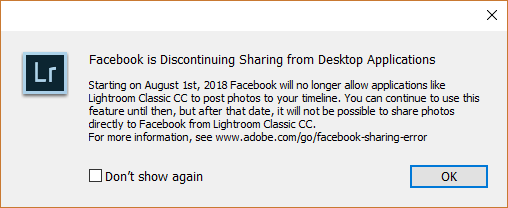
15 Jun 2018 – 500px no longer supports plug-ins
500px have announced that as of this date they will no longer support plug-ins like Photo Upload to access their site. This is a decision made by 500px and not by the plug-in.
There is no alternative plug-in available for uploading to 500x from Lightroom.
If this decision affects you then please contact 500px directly and mention that you use or rely on the Photo Upload plug-in for Lightroom. I have also contacted 500px.
24 Apr 2018 – Facebook prevents plug-in from creating posts on user timelines
Facebook have announced that on 1 Aug 2018 they are removing the ability for third party applications to create posts on user timelines. Facebook are still allowing posts to be created for Facebook pages.
Specifically, Facebook have prevented applications from being granted a permission called “publish_actions” that allows posts to be created on user timelines.
Update 20 Jul 2018 – Refer to the news on Facebook dated 20 Jul 2018 above.
23 Jan 2018 – Picasa Web uploads fail (“500” error)
The Picasa Web API that 3rd party apps use to upload and manage photos for Google Photos is giving an error when uploading photos. The error from Google simply says “Internal error, try again later”.
Many other people and apps have reported the same errors, for example see this thread (which has nothing to do with this plug-in).
There are no indications from Google that this is either a planned outage or a planned change, so at this time I have to assume that Google will fix the problem sooner than later. I will keep an eye on the situation over the next day or so, but there is nothing else I can do at this time.
Please be aware that that 12 months ago Google made it clear that Picasa Web was being retired and no longer developed. Sadly, Google do not allow 3rd party plug-ins to upload directly to Google Photos (they can only upload to Picasa Web). My suggestion is that it is time to start looking at alternative photo sites if you want to upload directly from Lightroom.
Update 25 Jan 2018 – Google have now fixed the problem and Picasa Web uploads work again.
27 Feb 2017 – SmugMug no longer allows photos to be uploaded to “Private” galleries
SmugMug have prevented photos from being uploaded to galleries that have their visibility set as “Private”.
I don’t know their rationale why and I even asked them why in their support forum, but no reply – https://dgrin.com/discussion/261330/cannot-upload-photos-to-private-galleries-using-v2-api. I’m not sure if SmugMug will fix this or if it is permanent.
You need to change the gallery visibility to “Public” or “Unlisted” then the upload should work.
Update 28 Jun 2017 – this is now fixed in plug-in version 4.5.7.
7 Feb 2017 – Picasa Web changes (e.g. albums cannot be created)
The Picasa Web API that 3rd party apps use to upload and manage photos for Google Photos has been updated by Google to prevent many update operations.
Google have now prevented the Picasa Web service from creating, renaming and deleting albums and from updating or deleting photos. If you are technically minded, please refer to this Google site for more information (see section titled “Mutation support removed”).
You can still upload photos using the latest version of the Photo Upload plug-in, and you can use the Google Photos website to create your albums before or after uploading to them from Lightroom.
Update 6 Sep 2018 – Google have released an official interface to Google Photos and this plug-in has been updated to support this interface. Please refer to the “Google Photos” service added to Photo Upload version 5.0.9. Google have announced that the old Picasa Web interfaces will be retired in Mar 2019.
Google Photos “shared albums”
Please note that Google does not tell the Picasa Web plug-in about any albums you initially create on Google Photos as “shared albums”. To work around this, please initially create albums on Google Photos as regular “albums” and then configure these to be shared albums afterwards.
7 Feb 2017 – Picasa Web uploads fail (“501” error)
The Picasa Web API that 3rd party apps use to upload and manage photos for Google Photos has been updated by Google to prevent many update operations. Older versions of the plug-in will display “501” errors from Google when trying to perform certain tasks like creating albums.
The Photo Upload plug-in has been updated with version 4.1.9 to handle these Google changes with “friendly” error messages. You should update your plug-in to 4.1.9 or later.
Please also refer to the note above on “Google Photos (Picasa Web) no longer allow albums to be created”.
Update 8 Feb 2017 – this is now fixed in Photo Upload version 4.1.9.
27 Jan 2017 – Picasa Web uploads fail (“400” error)
The Picasa Web API that 3rd party apps use to upload photos to Google Photos is reporting a “400” error with the message “Bad request”. This will affect all 3rd party apps that upload pictures using the Picasa Web API to Google Photos. There is a thread on the Google forums that is discussing the problem.
It is not known what causes the problem and when Google will fix the issue. I’d expect them to fix it quite quickly given the number of 3rd party apps that make use of uploading photos in this manner. I’ll track Google’s response – hopefully it will be quick and positive.
Update 28 Jan 2017 – this is now fixed in Photo Upload version 4.1.6. There has been no indication from Google what the problem is, but I’ve found an alternate way to upload the photos which appears to work well.
19 Apr 2016 – Facebook authentication fails
Facebook have mandated a few changes to authentication and old versions of the plug-in will receive a “URL blocked” message from Facebook when authenticating.
Update 19 Apr 2016 – this is now fixed in Photo Upload version 4.1.9.
16 Feb 2016 – Google announce changes to Picasa Web
Google recently announced that they will be making changes to the Picasa Web API that the Photo Upload for Picasa Web plug-in uses.
Google have been unclear about all the implications of these changes to applications such as the Photo Upload plug-in. However they have stated that changes to their API will not be made until 1 May 2016.
Google may keep the old Picasa Web API working, with some small changes or limitations. They may replace the API with a new alternative that the Photo Upload plug-in can use. Or they may do something else such as improve Google Drive integration for Google Photos, or remove third party API access to Google Photos entirely.
Google have noted that they will announce in March 2016 what the changes will be in detail, so until that time it is not possible to comment further on how Google’s plans will affect Photo Upload for Picasa Web.
Every effort will be made to ensure Photo Upload continues being able to upload your photos to Google Photos. When Google share more details of their plans then this news section will be updated with what this means for the Photo Upload plug-in. Until then, I’m afraid we have to be patient…
13 Nov 2015 – Lightroom hangs/freezes when closing
A few people have highlighted that Lightroom can hang/freeze when it is closing. Lightroom must then be force closed to make it quit properly. In some circumstances a window is shown during the hang that shows the Photo Upload plug-in is shutting down.
It appears that this is a problem with Lightroom, not with the Photo Upload plug-in. Please refer to this feedback page on the Lightroom forums:
http://feedback.photoshop.com/photoshop_family/topics/lightroom-2015-2-hangs-on-quit
The advice that seems to work fairly reliably is:
“Reset the preferences (holding down SHIFT and ALT and starting Lightroom) and choose YES.“
7 Oct 2015 – Zenfolio communication fails
During some scheduled maintenance on 6 or 7 Oct 2015 Zenfolio have changed the way security for internet communication is handled on their servers.
Update 7 Oct 2015 – this is now fixed in plug-in version 3.2.1.
31 Jul 2014 Old “Picasa Web Upload” plug-in replaced by “Photo Upload”
The old “Picasa Web Upload” plug-in originally launched in 2012 has been replaced by the “Photo Upload” plug-in which allows you to upload to Picasa Web and many other services.
The final version of the “Picasa Web Upload” plug-in is 1.5.8. If you have a version of the old Picasa Web Upload plug-in then please note that it is not possible to use it with Lightroom 7.0 or later. Instead please download the latest Photo Upload plug-in from this website. You can use your existing Picasa Web Upload plug-in license key with the Photo Upload plug-in’s Picasa Web service.
27 Jun 2014 – Flickr authentication fails
Flickr have changed the way authentication is handled on their servers.
Update 30 Jun 2014 – this is now fixed in plug-in version 1.7.9.
FAQ
Updating the plug-in – always check you have the latest
If you think you have a problem, in particular if you think you’ve found a bug, then please make sure you have the latest version of the plug-in.
Use the Update button in the plug-in’s settings from Lightroom Plug-in Manager to check that you have the latest.
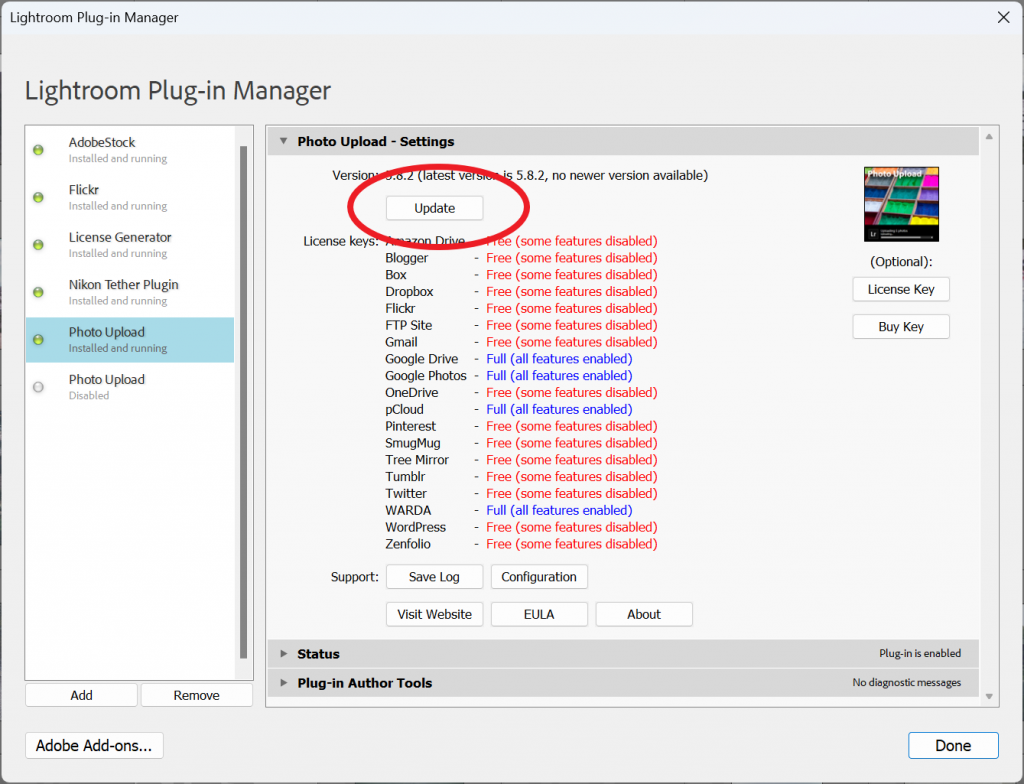
Downloaded plug-in from Adobe’s website and I have a ZXP file…
If you download the plug-in from Adobe’s Add-ons website then you will get a ZXP file. This type of file is intended to be opened by Adobe Creative Cloud (and Adobe Extension Manager.) If you don’t have Adobe Creative Cloud then you cannot do much with the ZXP file.
Adobe’s add-on installation process for Lightroom plug-ins is really quite complicated – and certainly convoluted.
My recommendation for a more straightforward install is to download the plug-in directly from this website. This will be a regular ZIP file rather than a proprietary Adobe ZXP file. And then simply follow the tried and tested installation instructions also on this website.
Lightroom reports “An error occurred while attempting to load this plug-in.“
When using Lightroom Plug-in Manager to Add a new plug-in, you may get an error reporting “An error occurred while attempting load this plug-in.“. This error normally means the plug-in folder has not been extracted correctly from the downloaded Zip file.
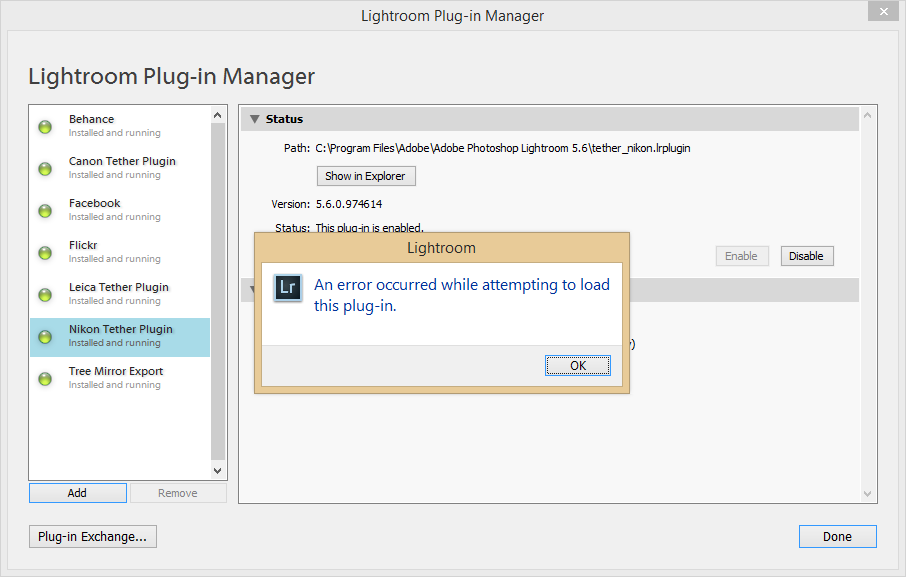
Lightroom expects all plug-ins to have a folder extension of “.lrplugin” or “.lrdevplugin”. When you download a plug-in Zip file from this website, the top-level in the Zip file will be a folder ending in “.lrplugin”, e.g. “photoupload.lrplugin”. You must extract this folder itself, not just the files within it. Once you’ve extracted the plug-in folder from the Zip, you can move it around your computer (e.g. to your Documents folder) but you must not rename the plug-in folder.
Missing plug-in – The “nil” plug-in is not installed
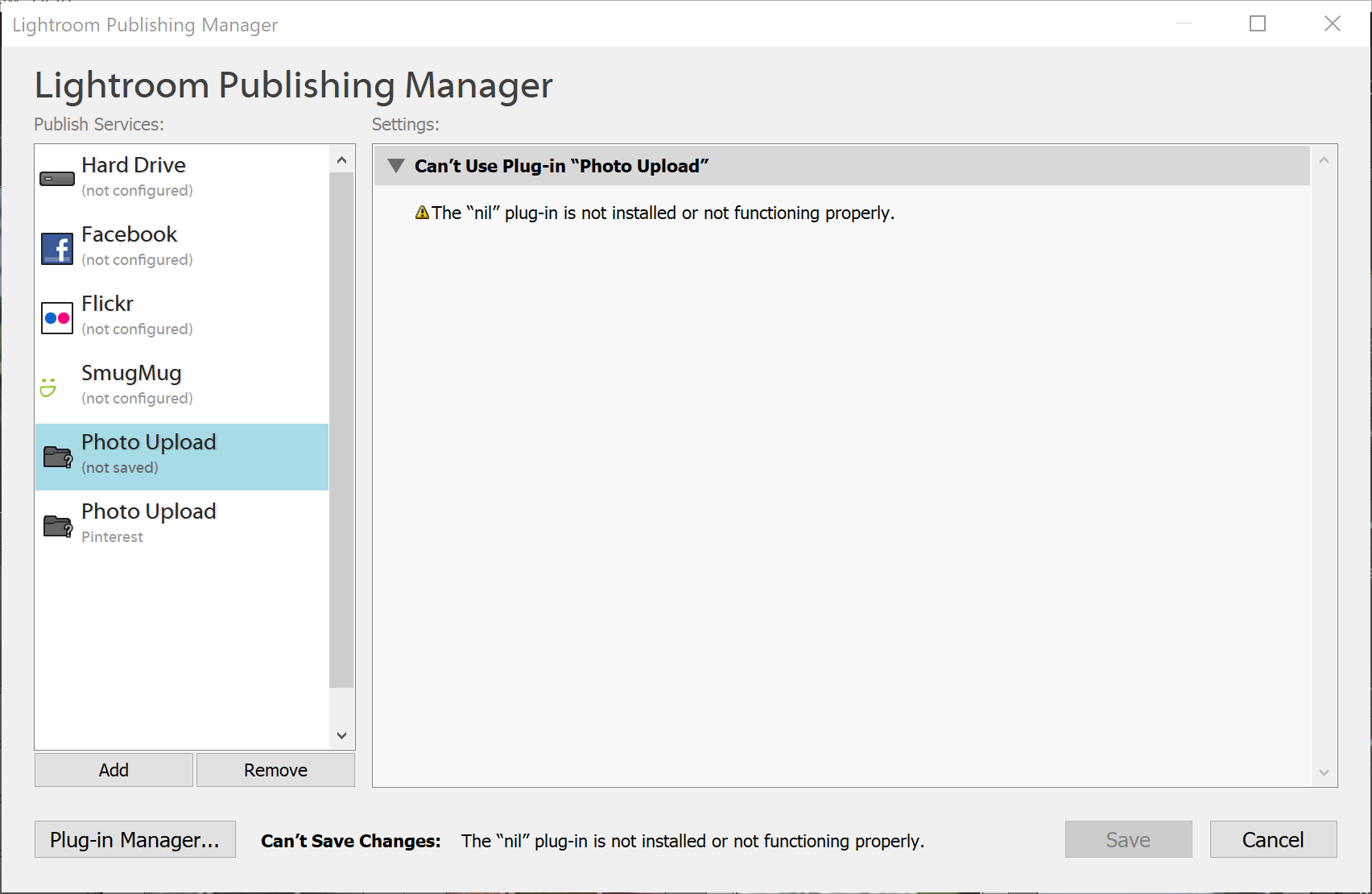
Lightroom indicates that the plug-in is missing or shows the message “The “nil” plug-in is not installed” if it cannot find the plug-in folder on your computer that you used when you added the plug-in to Lightroom.
After using Lightroom’s Plug-in Manager to add the plug-in to Lightroom, you must not remove the plug-in folder. Lightroom needs to load the plug-in from this folder each time it starts.
If you get this message, please re-install the plug-in by following the installation instructions.
Authentication problem – Error authenticating with [service]
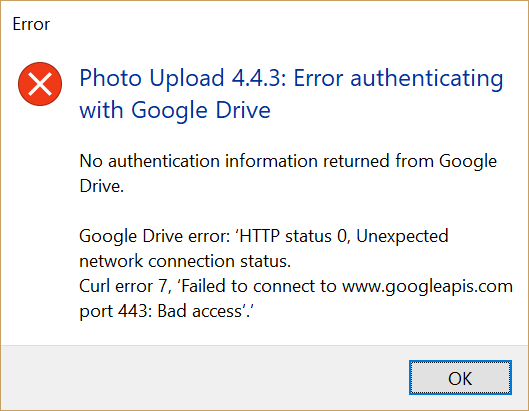
When trying to authenticate you may get an error such as this:
Photo Upload: Error authenticating with [service]No authentication information returned from [service].
The common answer to this is that you are running a firewall (e.g. Little Snitch etc.) and have restrictions on the plug-in’s network access.
Consider whether you currently have network problems or are running a restrictive firewall.
Most firewalls identify this plug-in’s network access as coming from “curl” rather than “Lightroom”. Please make sure your firewall permits network access for the “curl” application.
You can use the “Test Connection” window to test whether your internet connection is working for the plug-in. You can find the “Test Connection” window within the “Configuration” window under the plug-in’s Setting section in Lightroom’s Plug-in Manager.
What is the Export Location used for?
Lightroom provides a setting for the plug-in called “Export Location”. This allows you to specify where Lightroom should create the copy of each photo that you are exporting. Lightroom creates a copy for each photo according to your edits and settings. For example, if you’ve cropped your photo and want to export it as a JPEG then this is what the copy will consist of.
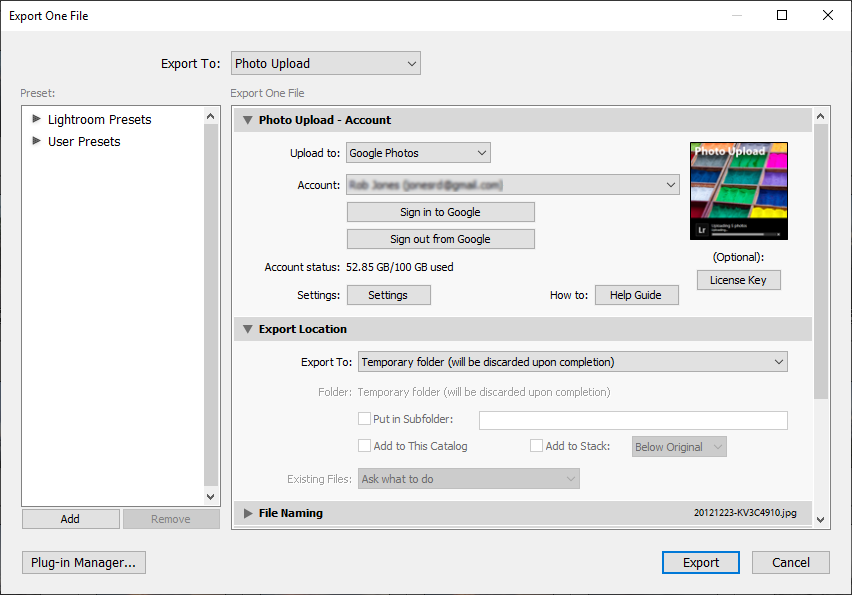
I recommend leaving the “Export Location” setting as the default which is “Temporary folder”. This means that the copy of the exported photos will be removed once they have actually been exported.
Lightroom says my computer is out of disk space
Now that online storage is cheap or even free, people want to upload their entire photo collection.
Some people are finding out that when exporting a large number of photos and videos that Lightroom reports that their computer is out of disk space. This problem typically occurs more frequently on systems that have smaller hard disks, e.g. those with 256GB or less SSDs.
At the start of a publish/export process Lightroom starts creating copies of each photo that you are uploading according to the publish/export settings you have specified. Lightroom does this in parallel to the actual uploading being done by the plug-in and does not wait for the plug-in to request each photo copy. Lightroom does not allow the plug-in to dictate when the photo copies are made and when they are deleted.
The out of disk space problem occurs because Lightroom creates all the photo copies at the start of the upload and only deletes the copies when the plug-in has finished uploading the final photo. The photo copies are created in the computer’s temp folder (on a Windows machine this is usually on the same drive as the main Windows installation, e.g. drive C:). You will need enough space in your temp folder (and drive) to allow Lightroom to create publish\export copies of all the photos that you are uploading in one operation. The space used by Lightroom during the upload will be freed up once the upload has finished.
e.g. If each exported photo that is generated by Lightroom is 5MB in size, and you are exporting 1,000 photos then you will need 5GB of free space in the temp folder on your computer.
Note: Work arounds for this Lightroom problem are 1) use the plug-in’s “Generate exports one at a time” setting or 2) use the Configuration setting “Temporary folder for exported photos” to override where the temp folder is.
For reference, here is how you can find out where your system temporary folder is that Lightroom will be using for the temporary files during an export/publish:
Win:
- Open Command Prompt
- Type:
echo %temp%
Mac:
- Open Terminal
- Type:
echo $TMPDIR
Location information not being uploading
Various online services (e.g. Google Photos) can make use of the photo location information in the photo’s metadata. If the location information is not being uploaded then check that you have enabled location information in Lightroom’s Export/Publishing Manager windows, i.e. you do not have “Remove Location Info” checked.
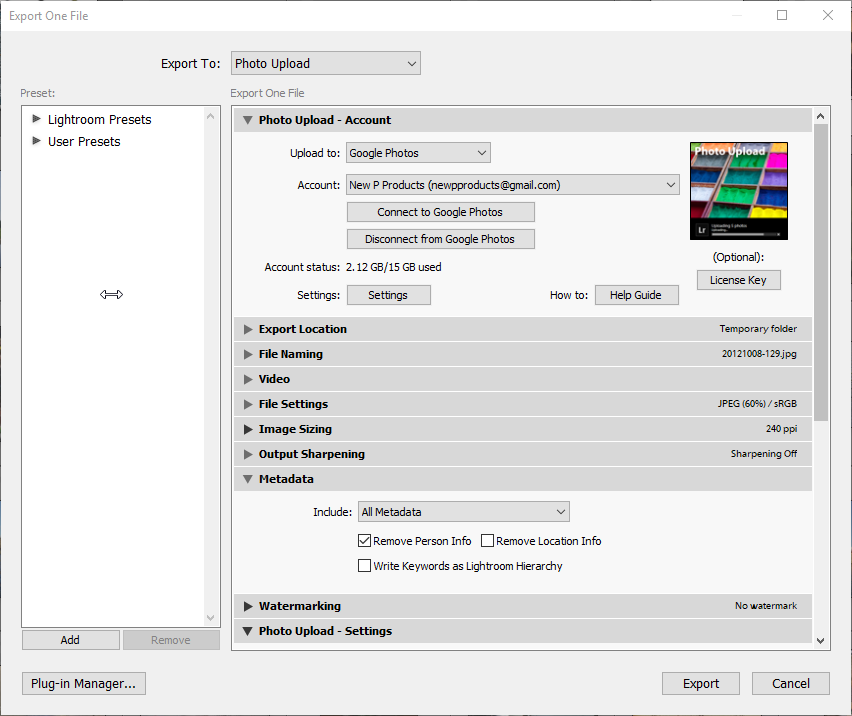
Old versions of Photo Upload for OneDrive (and the previous SkyDrive Upload) cannot be authenticated
Update your Photo Upload plug-in to a newer version (version 2.3.7 or later).
Microsoft appear to have changed something on their servers which requires an updated Photo Upload plug-in.
Use the Update button for the Photo Upload plug-in in Lightroom’s Plug-in Manager to get the latest version.
Note: If you are still using the old SkyDrive Upload plug-in then please take this opportunity to upgrade to the Photo Upload plug-in (your existing license key will still work).
WordPress self-hosted sites
The Photo Upload plug-in works with blogs hosted on wordpress.com and blogs that are self-hosted.
Authentication is always managed by wordpress.com, so you will need an account on wordpress.com even if you do not have a site hosted there.
- Create an account on wordpress.com (if you don’t have one already). This is free, you do not need to create a site on wordpress.com
- Install the Jetpack plug-in on your own self-hosted WordPress site (https://en-gb.wordpress.org/plugins/jetpack/)
- After the Jetpack plug-in is installed, connect it to your wordpress.com account (https://jetpack.com/support/installing-jetpack/)
- Log in to wordpress.com using your wordpress.com account and add your own self-hosted WordPress site (e.g. wordpress.de or personal domain) to your account
- In the Photo Upload plug-in in Lightroom, use the Add/Refresh button to authenticate the plug-in with any of the sites registered with your wordpress.com account
For self-hosted sites, you will need the Jetpack WordPress plug-in on your WordPress site. Ensure that you have version 3.1 or later of Jetpack installed. Version 3.0.2 of Jetpack had an error that prevented authentication. This Jetpack error was fixed in 3.1.
The plug-in cannot be authenticated with sites hosted locally at “localhost”. Authentication needs your WordPress site to be registered and accessible by wordpress.com. WordPress does not allow such local sites to be registered.
WordPress blog site selection
WordPress allows you register multiple blogs with your wordpress.com account. You can select from your available sites using the drop down list in your Web brower when authenticating the plug-in with WordPress.
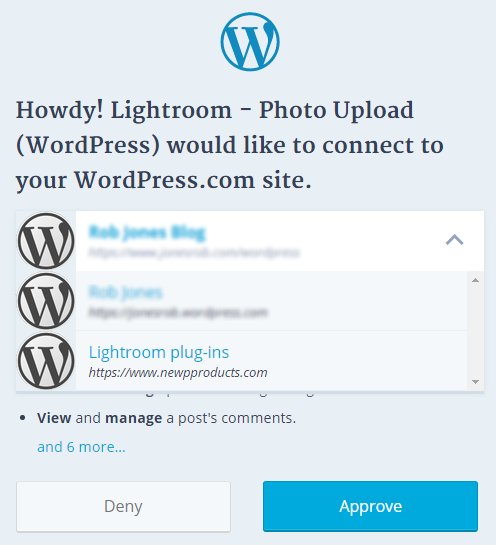
WordPress authentication does not return an authentication code
Sometimes WordPress plug-ins can prevent the Lightroom plug-in from authenticating with your site. These plug-ins prevent you receiving an authentication from WordPress, i.e. the page with the authentication code does not open in your browser.
The problematic WordPress plug-ins tend to be security ones. There are known issues with these WordPress plug-ins, but other security plug-ins are likely to interfere with authentication too:
- All In One WP Security
- iThemes Security Pro
If you do not receive an authentication code in your browser please disable the security plug-ins and try the authentication again. You should be able to re-enable the plug-ins after the authentication has successfully taken place.
Plug-in not compatible with your version of Lightroom
E.g. “Lightroom Version 5.3.0.938183 is incompatible with this plugin“.
You have an old version of the plug-in.
If your plug-in has an Update button then use that to update to the latest version.
If your plug-in does not have an Update button or you are having problems using the Update feature then simply download a new version from this website and manually replace your existing plug-in.
If you have the old Picasa Web Upload plug-in then please download the Photo Upload plug-in which now replaces it. Your old Picasa Web Upload license key will work with the new Photo Upload plug-in (for the Picasa Web service).
If you have the old SkyDrive Upload plug-in then please download the Photo Upload plug-in which now replaces it. Your old SkyDrive Upload license key will work with the new Photo Upload plug-in (for the OneDrive service).
If you have the old Tree Mirror Export plug-in then please download the Photo Upload plug-in which now replaces it. Use the Tree Mirror service in the new Photo Upload plug-in.
It depends where you installed the plug-in as to whether you can use the “Remove” button to remove the plug-in from Lightroom. It is greyed out if you installed to the following locations:
On Windows, either
\Users\%MyUserName%\AppData\Roaming\Adobe\Lightroom\Modulesor
\Program Files\Adobe\Lightroom 5.x\ModulesOn Mac,
/Library/Application Support/Adobe/Lightroom/ModulesTo remove the plug-in from these locations you have to manually remove the plug-in folder from the appropriate path.
To avoid this potential problem, I recommend installing the plug-in to:
On Windows,
\Documents\Lightroom plug-insOn Mac,
/ApplicationsUnreceived license key
If you purchase a license for the full version of the plug-in you will be sent 2 emails. One email will contain your order number and the second email will contain your license key. These emails will be sent to you immediately and automatically by the FastSpring payment service.
The license key email should be sent immediately – but on a few occasions it has taken 6 hours before it has been received.
If you think you should have received an email but have not received it then please first check your email junk or spam folders. The license keys and order receipts are sent by FastSpring – so it may help to search your junk/spam email folders for the name “FastSpring” or “mailer@fastspring.com”.
When a license key email has not been received there are typically two reasons:
- A private\corporate email domain is not processing the email correctly (sometimes the license key emails are identified as junk\spam). The most reliable email addresses tend to be from mainstream domains such gmail.com or live.com.
- An incorrect email address being entered during the order.
If you think either of the above apply then please contact FastSpring (support@fastspring.com) with your order number.
Unreceived license key (purchased from the Adobe Add-ons website)
If the above tips for finding your license key have not helped, AND you bought the plug-in from the Adobe website (i.e. not via the plug-in or this website) then you will need to contact Adobe for further assistance.
Please note that, as the plug-in developer and not an Adobe employee, I cannot access the payment and licensing systems used by Adobe. Therefore if you have purchased your license key from the Adobe Add-ons website you will need to contact them regarding any unreceived license keys.
Here’s a thread on the Adobe forums that gives the email address to contact that another customer was given.
Lost my license key
If you’ve bought your license from this website and lost your license key then please use the email address on the Contact page to get in touch. Please provide the reference number for your original purchase or the email address that you originally used.
Lost license keys purchased from the Adobe Add-ons website
If you’ve bought the license from the Adobe Add-ons website then you will need to contact them to have your license key sent out again.
Plug-in says the license key is invalid
When copying and pasting your license key from your license email into the plug-in, take care that the key is copied as one long list of characters.
Your email system may insert line breaks or spaces into the email, so please be sure that any such line breaks, spaces or other formatting from the email message are not pasted into the plug-in’s license text box.
If your license key is still reported as being invalid after copying and pasting it then please check you have specified the License service correctly in the license key entry window. e.g. If you have purchased a license for Dropbox then please make sure Dropbox is the selected License service in the window.
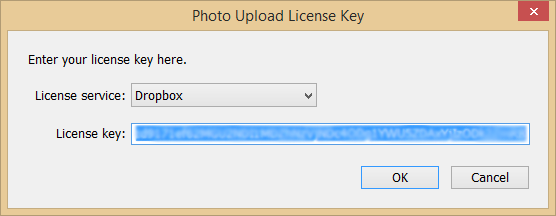
A common mistake is trying to enter a Google Drive license key for Google Photos. Please be careful when purchasing licenses and entering the license keys that you have selected Google Drive or Google Photos correctly.
Can I rename the plug-in folder?
The plug-in folder should be named with a “lrplugin” or “lrdevplugin” extension. For example:
photoupload.lrplugin
or
picasawebupload.lrdevplugin
On Mac, if you open (i.e. extract) the downloaded Zip file a second time you will get a folder with the suffix “2”. Lightroom will not be able to read the plug-in from such a named folder. Before opening the Zip file consider removing an existing plug-in folder.
The following will give an error as the folder extension “.lrplugin 2” is not “.lrplugin” as Lightroom expects:
photoupload.lrplugin 2
If you really need two versions of the plug-in on your computer, I recommend having two separate parent folders and keeping the plug-in folder name the same, i.e.:
Windows,
\Documents\Lightroom plug-ins\picasawebupload.lrplugin \Documents\Lightroom plug-ins\V2\picasawebupload.lrplugin
Mac,
/Documents/Lightroom plug-ins/picasawebupload.lrplugin /Documents/Lightroom plug-ins/V2/picasawebupload.lrplugin
Google’s Picasa Web photo size constraints
The Picasa Web plug-in uses Google’s Picasa Web interface to upload photos to Picasa Web and Google Photos.
The Picasa Web interface has a restriction of a maximum photo size of 2048 x 2048 pixels if photos are not to be counted towards your allowance.
Please note that Google currently only provides “unlimited high quality photos” via its own mobile apps and website. Google does not allow any third party applications such as the Photo Upload plug-in to use those constraints.
However, once your photos have been uploaded to Picasa Web or Google Photos, you can then follow these instructions to recover the storage space:
https://support.google.com/photos/answer/6314648
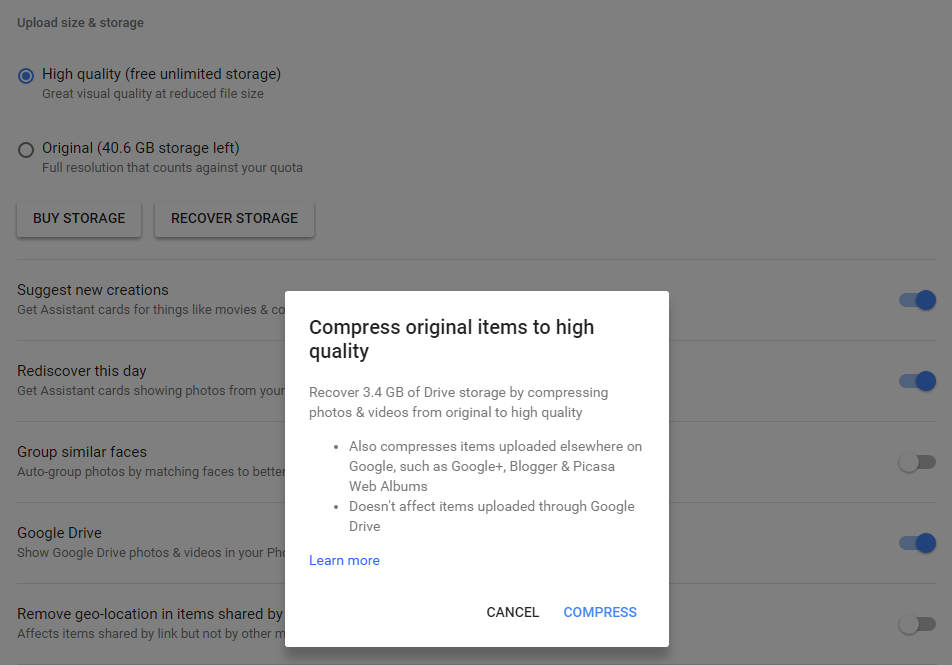
Create multiple publish services
If you want to use the Photo Upload plug-in with multiple services (e.g. Picasa Web and Google Drive) then you create additional publish services by right clicking on an additional publish service and choosing “Create new publish service…”. You can then choose a new upload service, account and settings for this additional publish service.

Checking the version of your plug-in
You may need to check which version of a plug-in you are using. You can do this from Lightroom’s Plug-in Manager.
Select the plug-in on the left (e.g. Photo Upload).
The plug-in version number is displayed on the right in both the plug-ins Settings and Status panes (in the example below the version is 1.5.5).
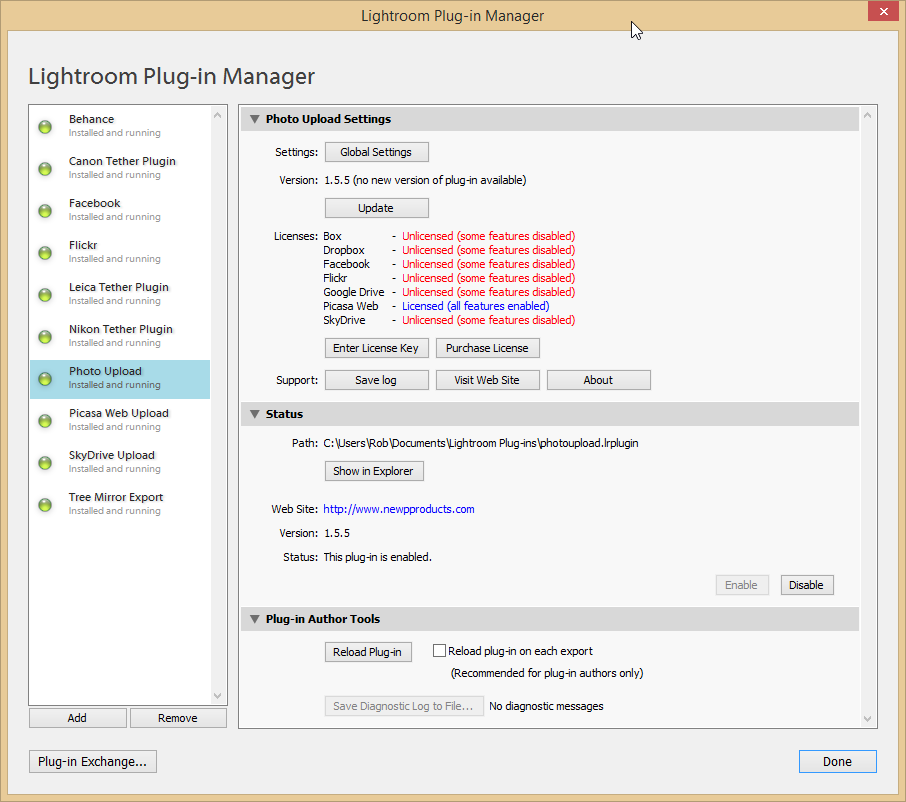
Removing a plug-in
Sometimes you may need to remove your plug-in, perhaps to replace it with a newer version.
Lightroom’s Plug-in Manager allows you to unregister a plug-in from Lightroom using the “Remove” button, but in most cases I recommend actually deleting the plug-in folder from your system. This is particularly important if you are upgrading the plug-in with a new version – always delete the old plug-in folder first so that there is no doubt which version of the plug-in Lightroom will be using.
You can find the installation folder of your plug-in from Lightroom’s Plug-in Manager.
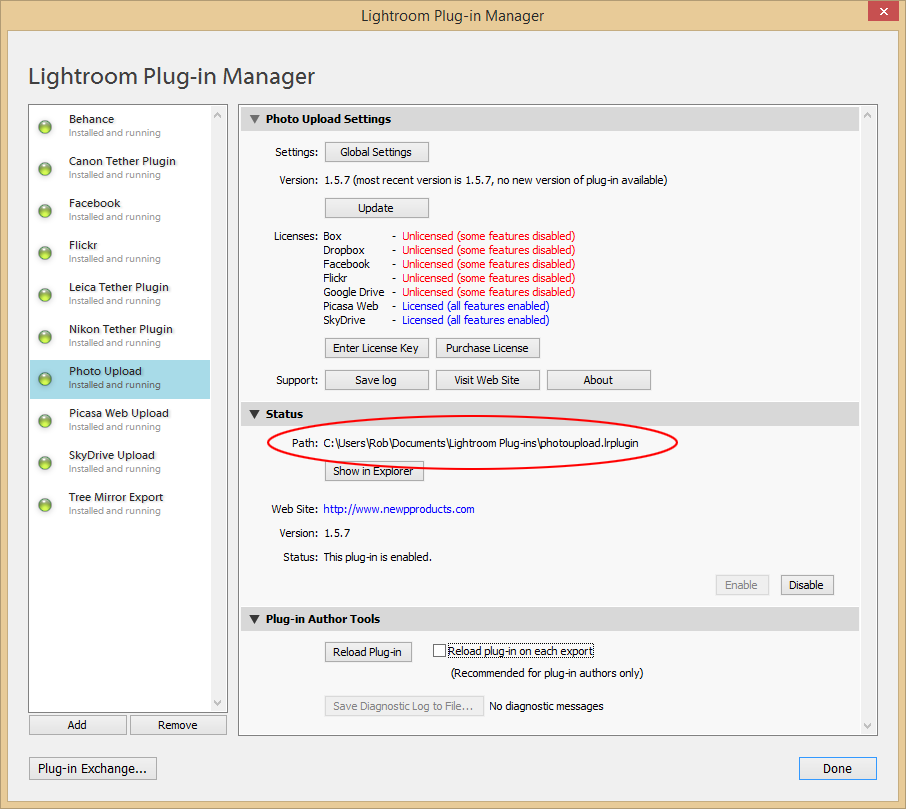
To remove the plug-in simply identify the install folder (highlighted in the above Plug-in Manager screenshot). You can then delete it using either Windows Explorer or Mac’s Finder.
You can use Lightroom’s Plug-in Manager’s “Show in Explorer” or “Show in Finder” buttons to go straight to the folder, making it easy to find the plug-in folder on your system.
Saving your log file
In order to try and help identify a problem, I may ask you to send me a plug-in log file from your machine. If I request this, please follow the instructions below:
1. Do the activity that doesn’t appear to be working, e.g. try uploading a photo. This is important so that the problematic behaviour is recorded in the log file.
2. Save your plug-in’s log file. From the “Plug-in Manager” window in Lightroom, select the “Save log” option from the plug-in’s settings section of the window.
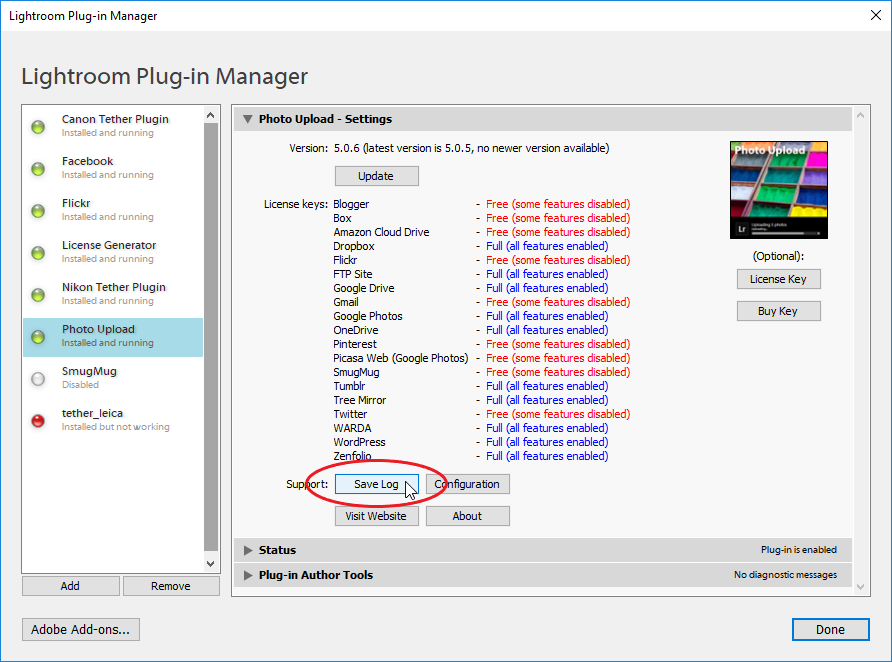
3. Email the log file to me. Attach the log file from the place where you saved it into an email and send it to me.
Leave a Reply